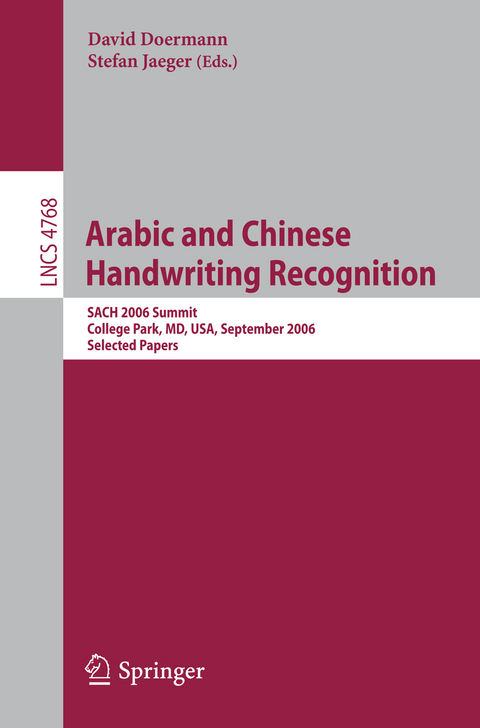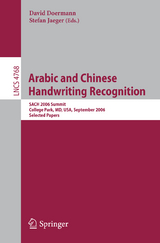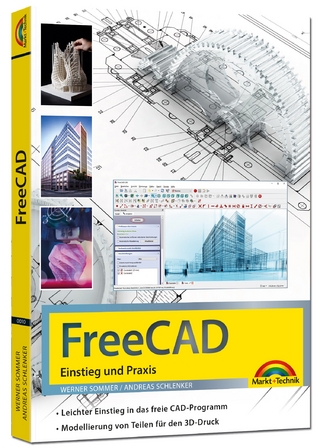Arabic and Chinese Handwriting Recognition
Springer Berlin (Verlag)
978-3-540-78198-1 (ISBN)
In the fall of 2006, the University of Maryland, along with various government and industrial sponsors, invited leading researchers from all over the world to a two-day Summit on Arabic and Chinese Handwriting Recognition (SACH 2006). The event acted as a complement to the biennial Symposium on Document Image Understanding Technology (SDIUT), providing a focused glimpse into the state of the art in Arabic and Chinese handwriting recognition. It offered a forum for interaction with prominent researchers at the forefront of the scientific community and provided an opportunity for participants to help explore possible directions of the field. This book is a result of the expansion, peer review, and revision of selected papers presented at this meeting. Handwriting recognition remains the Holy Grail of document analysis, and Arabic and Chinese scripts embrace many of the most significant challenges. We are pleased to have 16 scientific papers covering the original topics of handwritten Arabic and Chinese, as well as 2 papers covering other handwritten scripts. We asked each author to not only describe the techniques used in addressing the problem, but to attempt to identify the key research challenges and problems that the community faces. The result is an impressive collection of manuscripts that provide various detailed views of the state of research. In this book, six articles deal directly with Arabic handwriting. - Cheriet provides an overview of the problems of Arabic recognition and how systems can use natural language processing techniques to correct errors in lexicon-based systems.
Visual Recognition of Arabic Handwriting: Challenges and New Directions.- A Review on Persian Script and Recognition Techniques.- Human Reading Based Strategies for Off-Line Arabic Word Recognition.- Versatile Search of Scanned Arabic Handwriting.- A Two-Tier Arabic Offline Handwriting Recognition Based on Conditional Joining Rules.- Databases and Competitions: Strategies to Improve Arabic Recognition Systems.- Handwritten Chinese Character Recognition: Effects of Shape Normalization and Feature Extraction.- How to Deal with Uncertainty and Variability: Experience and Solutions.- An Efficient Candidate Set Size Reduction Method for Coarse-Classification in Chinese Handwriting Recognition.- Techniques for Solving the Large-Scale Classification Problem in Chinese Handwriting Recognition.- Recent Results of Online Japanese Handwriting Recognition and Its Applications.- Segmentation-Driven Offline Handwritten Chinese and Arabic Script Recognition.- Multi-character Field Recognition for Arabic and Chinese Handwriting.- Multi-lingual Offline Handwriting Recognition Using Hidden Markov Models: A Script-Independent Approach.- Handwritten Character Recognition of Popular South Indian Scripts.- Ensemble Methods to Improve the Performance of an English Handwritten Text Line Recognizer.
| Erscheint lt. Verlag | 3.4.2008 |
|---|---|
| Reihe/Serie | Image Processing, Computer Vision, Pattern Recognition, and Graphics | Lecture Notes in Computer Science |
| Zusatzinfo | VIII, 279 p. |
| Verlagsort | Berlin |
| Sprache | englisch |
| Maße | 155 x 235 mm |
| Gewicht | 456 g |
| Themenwelt | Informatik ► Grafik / Design ► Digitale Bildverarbeitung |
| Informatik ► Theorie / Studium ► Künstliche Intelligenz / Robotik | |
| Schlagworte | Biometric applications • classification • Cognition • Commercial Systems • Databases • feature extraction • Handwriting Models • Handwritten OCR • Hardcover, Softcover / Informatik, EDV/Informatik • HC/Informatik, EDV/Informatik • Information Retrieval • language • Language Identification • Linguistic Processing • Performance • Preprocessing and Segmentation • Uncertainty |
| ISBN-10 | 3-540-78198-6 / 3540781986 |
| ISBN-13 | 978-3-540-78198-1 / 9783540781981 |
| Zustand | Neuware |
| Informationen gemäß Produktsicherheitsverordnung (GPSR) | |
| Haben Sie eine Frage zum Produkt? |
aus dem Bereich




